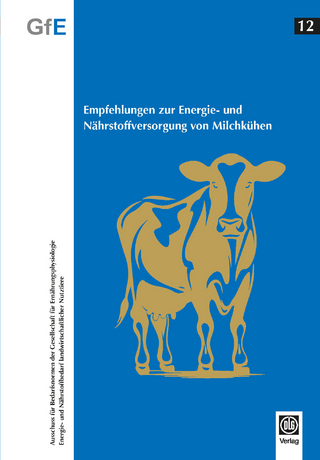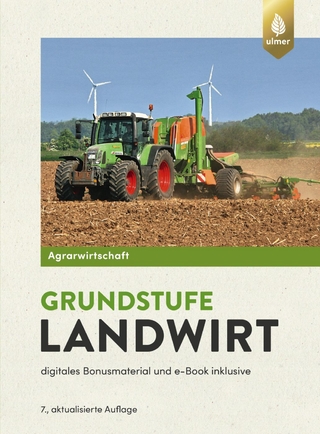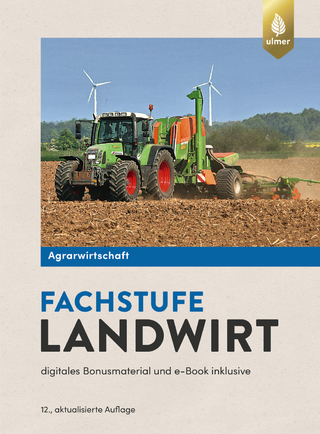
Sustainable Fishery Systems
John Wiley & Sons Inc (Verlag)
978-1-119-51179-3 (ISBN)
- Lieferbar (Termin unbekannt)
- Versandkostenfrei innerhalb Deutschlands
- Auch auf Rechnung
- Verfügbarkeit in der Filiale vor Ort prüfen
- Artikel merken
Fisheries, whether small-scale or large-scale, are filled with complexity and uncertainty. Making the right decisions to successfully manage fisheries for sustainability and resilience requires a systems approach — including both natural and human elements, and their many interactions. To understand fisheries, and how they change over time, a diverse range of fishery knowledge must be brought together.
Sustainable Fishery Systems, 2nd edition meets these needs. The new edition provides essential information that can be readily applied within government, community, industrial, academic and research settings.
Sustainable Fishery Systems, 2nd edition retains the first edition’s emphasis on themes such as sustainability, resilience, uncertainty, complexity, and conflict, and expands its treatment of topics that have, since the first edition’s publication, become crucial to consider in the field of fisheries. As a result, readers will find:
Updated and expanded coverage of topics including coastal conservation, ecosystem-based management, co-management, community-based management, and more
New chapters covering connections between fisheries and marine protected areas, biodiversity conservation, climate and fisheries, and multi-sectoral management
A more detailed introduction to the “systems” perspective of fisheries, reflecting the substantial growth in that subject’s importance, and covering in detail the natural, human and governance aspects of fisheries.
Sustainable Fishery Systems, 2nd edition is an indispensable interdisciplinary resource for educators, researchers, government agencies, and fisheries managers.
Anthony Charles, PhD, is Director of the School of the Environment and Professor in the Sobey School of Business at Saint Mary’s University, Halifax, Canada.
Preface and Guide to the Book xv
Acknowledgements xviii
Part I Fishery Systems 1
1 Introducing Fishery Systems 3
1.1 Sustainability and Resilience 3
1.2 Rationale for a Systems Approach 6
1.3 Fishery Systems as Social-Ecological Systems 7
1.4 Depicting Fishery Systems 10
1.4.1 Fishing Effort 10
1.4.2 Adding Dynamics 11
1.4.3 Adding Complexity 12
1.4.4 The Fishery System 13
1.4.5 Alternatives 14
1.5 Characterising Fishery Systems 18
1.5.1 Small-Scale Versus Large-Scale Fishery Systems 18
1.5.2 Spatial Scale and Time Scale 21
1.5.2.1 Spatial Scales 21
1.5.2.2 Time Scales 22
1.5.3 Other Approaches to Characterising Fishery Systems 23
1.6 Complexity 24
1.7 Next Steps 25
2 The Natural System: The Fish 27
2.1 What Is Caught in Fishery Systems? 28
2.1.1 Fishes 30
2.1.1.1 Inland (Freshwater) Fish 31
2.1.1.2 Pelagic Marine Fish 31
2.1.1.3 Demersal Marine Fish 32
2.1.2 Shellfish 33
2.1.3 Characteristics 37
2.2 Spatial Distribution of Fished Resources 38
2.3 Fish Dynamics 41
2.3.1 Single-Species Dynamics 41
2.3.2 Multi-Species Dynamics 45
3 The Natural System: Fishery Ecosystems 48
3.1 Ecosystems 48
3.1.1 Aquatic/Fishery Ecosystems 50
3.1.2 A Typology of Fishery Ecosystems 52
3.2 Biodiversity 55
3.3 The Physical–Chemical Environment 58
3.3.1 The Winds 58
3.3.2 Ocean Currents 59
3.3.3 Upwellings 61
3.3.4 Other Relatively Localised Phenomena 61
3.3.5 Physical Features 62
3.4 Dynamics of Fishery Ecosystems and the Biophysical Environment 62
4 The Human System: Fishers and Fishworkers 65
4.1 Fishers and Fishworkers 65
4.1.1 A Typology of Fishers 66
4.1.2 Women in Fishing 70
4.1.3 Fishworkers in the Post-Harvest Sector 73
4.1.4 Fisher Organisations 73
4.2 Fishing Methods 75
4.2.1 A Typology of Fishing Methods 75
4.2.1.1 Seines/Encircling Gear 77
4.2.1.2 Trawls and Other Towed/Dragged Gear 77
4.2.1.3 Gill Nets and Entangling Nets: Drift and Static Gear 77
4.2.1.4 Traps and Pots 78
4.2.1.5 Lines 78
4.2.1.6 Other Methods 78
4.2.2 The Choice of Fishing Method 79
4.2.2.1 Biological 80
4.2.2.2 Economic 80
4.2.2.3 Social and Governance 80
4.3 Fisher and Fleet Dynamics 80
4.3.1 Dynamics of Fishing Effort 81
4.3.2 Capital Dynamics and Fishing Capacity 83
4.3.3 Technological Dynamics 85
4.3.4 Fleet Dynamics 86
5 The Human System: Post-Harvest Aspects and Fishing Communities 89
5.1 The Post-Harvest Sector of the Fishery 89
5.1.1 Processing 92
5.1.2 Marketing and Markets 95
5.1.2.1 Marketing 95
5.1.2.2 Markets 96
5.1.3 Distribution and Trade 98
5.1.3.1 Distribution 98
5.1.3.2 Trade 98
5.1.4 Consumers 99
5.1.4.1 Consumer Preferences 99
5.1.4.2 Consumer Demand 100
5.1.5 Food Security 101
5.2 Fishing Households and Communities 102
5.2.1 Households 102
5.2.2 Communities 105
5.3 The Socioeconomic Environment 108
5.3.1 Links of Fishery Systems and Their Socioeconomic Environment 108
5.3.2 Labour 108
5.3.2.1 Labour Mobility 109
5.3.2.2 Effects on the Fishery 110
5.4 Post-Harvest and Fishing Community Dynamics 111
5.4.1 Dynamics of Markets and Consumer Demand 111
5.4.2 Dynamics of Communities and the Socioeconomic Environment 112
Part II The Fishery Governance and Management System 115
6 Fishery Governance 117
6.1 Rationale for Governance and Management 117
6.1.1 Open Access 118
6.1.2 The Need for Management 118
6.1.3 The Need for Participatory Management 119
6.2 Governance and Management 123
6.3 Fishery Values and Objectives 125
6.3.1 A Portfolio of Fishery Objectives 127
6.3.2 Objectives, Priorities, and Conflict 129
6.4 Fishery Management Institutions 131
6.4.1 Types and Roles of Institutions 131
6.4.2 The Choice of Institutions 132
6.4.3 Examples of Institutions 132
6.5 Governance of International Fisheries 137
6.6 Legal Framework 138
6.6.1 Legal Pluralism 139
6.7 Dynamics of Fishery Governance 140
7 Fishery Management 142
7.1 Time Scales of Management 143
7.2 Spatial Scales of Management 143
7.2.1 International Coordination 145
7.2.2 Decentralisation/Devolution 145
7.3 Appropriate Fishing Effort and Catch Levels 147
7.3.1 The Yield-Effort Curve 147
7.3.2 The Gordon–Schaefer Graph 149
7.3.3 Fishery Objectives Influence the Choice of Effort Levels 150
7.4 Developing a Portfolio of Fishery Management Measures 153
7.5 Implementation at the Operational Level 154
7.6 Fishery Enforcement 156
7.7 A Survey of Fishery Management Measures 157
7.7.1 Input (Effort) Controls 158
7.7.1.1 Limited Entry 158
7.7.1.2 Limiting the Capacity per Fisher or per Vessel 158
7.7.1.3 Limiting the Intensity of Operation 158
7.7.1.4 Limiting Time Fishing 158
7.7.1.5 Limiting the Location of Fishing 159
7.7.1.6 Challenges with Input Controls 160
7.7.2 Output (Catch) Controls 160
7.7.2.1 Total Allowable Catch 161
7.7.2.2 Individual Quotas 162
7.7.2.3 Community Quotas 162
7.7.2.4 Escapement Controls 163
7.7.2.5 Challenges with Output Controls 163
7.7.3 Technical Measures 164
7.7.3.1 Gear Restrictions 165
7.7.3.2 Size Limits 166
7.7.3.3 Closed Areas 166
7.7.3.4 Closed Seasons 167
7.7.4 Ecologically Based Management 168
7.7.4.1 Taxes and Royalties 169
7.7.5 Subsidies 170
7.8 Dynamics of Fishery Management 172
8 Fishery Development 174
8.1 Rationale for Fishery Development 174
8.2 Objectives of Fishery Development 175
8.3 Strategic Choices in Fishery Development 178
8.3.1 New Fisheries 178
8.3.2 Existing Fisheries 179
8.3.3 Integrated Development 180
8.4 Targeting Fishery Development 181
8.4.1 Needs Assessment 181
8.4.2 Positive Signs 181
8.4.3 Other Considerations 182
8.5 Options for Fishery Development 183
8.5.1 Direct Support to Fishing Activities 183
8.5.2 Institutional Enhancement 183
8.5.3 Training and Human Resource Development 183
8.5.4 Economics and Planning 184
8.5.5 Scientific, Assessment, Statistical, and Information Support 184
8.5.6 Fisheries Management and Monitoring/Control/Surveillance 184
8.5.7 Post-Harvest Support 185
8.6 Participatory Fishery Development 185
9 Fishery Knowledge 187
9.1 The Nature of Fishery Knowledge 188
9.2 The Knowledge of Indigenous Peoples, Fishers, and Communities 189
9.2.1 Traditional Ecological Knowledge (TEK) 190
9.2.2 Indigenous Knowledge 190
9.2.3 Fisher Knowledge and Local Knowledge 192
9.3 Connecting Fisher/Local/Indigenous Knowledge with Fishery Science/ Research 195
9.4 Knowledge Within Institutions 198
9.4.1 Governments 198
9.4.2 International Agencies 199
9.4.3 Universities 199
9.4.4 Private Sector and Nongovernmental Organisations (NGOs) 200
9.5 Fishery Knowledge: The Natural System 200
9.5.1 Stock Assessment 201
9.5.1.1 Stock Assessment Process 201
9.5.1.2 Evolution of Stock Assessment: Single Species and Multi-Species 202
9.6 Fishery Knowledge: The Human System 205
9.7 The Nature of Knowledge Production 208
9.7.1 Disciplinary Knowledge 208
9.7.2 Multidisciplinary, Interdisciplinary, Transdisciplinary Approaches 209
9.7.2.1 Multidisciplinary 209
9.7.2.2 Interdisciplinary 209
9.7.2.3 Transdisciplinary 209
9.7.3 Pure (Basic) and Applied (Targeted) Knowledge 211
9.8 The Structure of Knowledge Production 211
9.8.1 Organized by Species 211
9.8.2 Organized by Function 212
9.8.3 Organized on a Geographical/Ecosystem Basis 213
9.9 Dynamics of Fishery Knowledge 213
Part III Three Major Challenges in Fishery Systems 215
10 Uncertainty in Fishery Systems 217
10.1 Sources of Uncertainty in Fishery Systems 218
10.1.1 Sources in the Natural System 218
10.1.2 Sources in the Human System 218
10.2 A Typology of Uncertainty 219
10.2.1 Introduction: The Stock–Recruitment Relationship 219
10.2.2 Randomness 220
10.2.3 Uncertainties in Data and Parameters 221
10.2.4 Structural Uncertainty 222
10.3 Linking Uncertainty and Dynamics 224
11 Conflict in Fishery Systems 227
11.1 Conflict over Priorities: Fishery Paradigms 229
11.1.1 The Conservation Paradigm 230
11.1.2 The Rationalisation Paradigm 230
11.1.3 The Social/Community Paradigm 231
11.1.4 Fishery Paradigms in Practice: Efficiency and Allocation 232
11.2 A Typology of Fishery Conflicts 234
11.2.1 Fishery Jurisdiction 235
11.2.2 Management Mechanisms 236
11.2.3 Internal Allocation 236
11.2.4 External Allocation Conflicts 237
11.2.4.1 Domestic Versus Foreign Fisheries 237
11.2.4.2 Fishers Versus Fish Farming (Aquaculture) 238
11.2.4.3 The Fishery Versus Competing Industries 239
12 Attitudes (The Story of a Fishery Collapse) 242
12.1 The Cod Collapse Experience 242
12.1.1 The Collapse 242
12.1.2 The Aftermath 243
12.1.3 Understanding the Collapse 244
12.1.4 Recovery? 245
12.1.5 The Future 246
12.2 Attitudes Underlying the Cod Collapse 246
12.2.1 The Role of the Regulator 247
12.2.2 Blame for the Collapse 248
12.2.3 The Burden of Proof 250
12.2.3.1 Stock Assessment 250
12.2.3.2 Fishing Gear 251
12.2.4 Conservation Can Wait 252
12.2.5 The Illusion of Certainty and the Fallacy of Controllability 254
12.2.6 Synthesis on Fishery Attitudes 256
Part IV Modern Strategies for Fishery Systems 259
13 Sustainability and Resilience 261
13.1 Sustainability 262
13.2 Resilience 265
13.3 The Sustainable Development Goals (SDGs) 268
13.4 Components of Sustainability and Resilience 268
13.5 Sustainability and Resilience of Institutions 273
13.5.1 Institutional Sustainability 273
13.5.2 Institutional Resilience 274
13.5.3 Institutional Effectiveness 275
13.6 Sustainability and Resilience within the Fishery System 277
13.6.1 Biodiversity 278
13.6.2 Fishing Fleets, Capacity, and Subsidies 279
13.6.3 Efficiency 282
13.6.4 Livelihood Diversity 283
13.6.4.1 Encourage Multi-Species Fisheries 284
13.6.4.2 Encourage Multiple Sources of Livelihood for Fishers 284
13.6.4.3 Diversify (Broaden the Base of) the Fishery-Dependent Economy 284
13.6.5 Post-Harvest and Fishing Communities 285
13.6.6 Fishery Objectives and Principles 285
13.6.7 Managing Conflict 286
13.7 Assessing Sustainability and Resilience in Fishery Systems 287
13.7.1 Sustainability Indicators 288
13.7.2 Resilience Assessment and Indicators 294
13.7.3 Developing a Framework of Indicators 296
14 Adaptive, Robust, and Precautionary Management 298
14.1 Uncertainty and Risk 298
14.2 Risk Assessment 299
14.3 Risk Management: Analytical Approaches 300
14.4 Adaptive Management and Robust Management 303
14.4.1 Adaptive Management 303
14.4.1.1 Flexibility 304
14.4.1.2 Adaptive Management Concepts and Methods 305
14.4.2 Structural Uncertainty and Robust Management 306
14.5 Moving to Robust, Adaptive Management 307
14.5.1 Avoiding the Illusion of Certainty 307
14.5.2 Avoiding the Fallacy of Controllability 308
14.5.3 Avoiding Lack of Robustness (Using a Management Portfolio) 309
14.6 The Precautionary Approach and the Burden of Proof 313
14.6.1 Approach Versus Principle 314
14.6.2 Implementing the Precautionary Approach 315
14.6.3 The Burden of Proof 316
14.6.4 Possible Applications of the Precautionary Approach and the Burden of Proof 316
14.6.4.1 The Stock–Recruitment Relationship 317
14.6.4.2 Over-Fishing Versus the Environment 317
14.6.4.3 Habitat Protection 318
15 The Ecosystem Approach to Fisheries 321
15.1 Rationale for an Ecosystem Approach 321
15.2 History of an Ecosystem Approach 322
15.3 Scope of an Ecosystem Approach 325
15.4 The Ecosystem Approach to Fisheries (EAF) 328
15.5 Implementing EAF 330
15.5.1 Principles 331
15.5.2 Entry Points 332
15.5.3 Resources for Implementation 333
15.6 Implementing EAF: Human Dimensions 334
15.6.1 Components of Human Dimensions 335
15.6.1.1 Social 335
15.6.1.2 Cultural 336
15.6.1.3 Economic 336
15.6.1.4 Political 336
15.6.1.5 Legal and Institutional 336
15.6.2 Human Dimensions Across Scales 337
16 Rights-Based Approaches to Fisheries Management 341
16.1 The Rationale for Fishery Rights 341
16.2 Use Rights 342
16.3 Management Rights 345
16.4 Use Rights and Management Rights in Context 346
16.5 Rights Versus Ownership 350
16.6 The Commons 351
16.7 Human Rights 353
16.8 Practicalities of Use Rights 358
16.9 Forms of Use Rights 359
16.9.1 Customary Tenure/Territorial Use Rights in Fishing (TURFs) 359
16.9.2 Limited Entry 363
16.9.3 Effort (Input) Rights 364
16.9.4 Catch (Output) Quotas 366
16.9.4.1 Individual Quotas and ITQs 367
16.9.4.2 Concerns with ITQs 369
16.9.4.3 Community Quotas 370
16.9.5 Community-Based Use Rights 371
16.10 Use Rights Issues: Initial Allocation 374
16.11 Use Rights Issues: Transferability 375
16.11.1 Efficiency 376
16.11.2 Social Cohesion 377
16.11.3 Concentration of Rights 377
16.12 Choosing a Use Rights System 379
17 Co-management and Community-Based Management 382
17.1 Fishery Co-management 382
17.1.1 Who Is Involved in Co-management? 383
17.1.2 Goals of Co-management 386
17.1.3 Forms of Co-management 386
17.1.3.1 Fisher–Government Co-management 387
17.1.3.2 Community-Based Co-management 388
17.1.3.3 Multi-Stakeholder Co-management 391
17.1.4 Levels of Co-management 393
17.1.5 Co-management and Components of Fishery Management 395
17.1.6 Discussion 397
17.2 Community-Based Fishery Management 397
17.2.1 What Is Community-Based Fishery Management? 398
17.2.2 Rationale for Community-Based Fishery Management 399
17.2.3 What Is Involved in Community-Based Fishery Management? 400
17.2.4 Experiences with Community-Based Fishery Management 401
17.2.5 Community-Based Conservation 403
17.2.6 Community Science 406
17.2.7 Factors of Success in Community-Based Fishery Management 407
Part V Fisheries and the Bigger Picture 411
18 Fisheries and Marine Protected Areas 413
18.1 Fishery Closed Areas 413
18.2 Nongovernmental (Informal) Protected Areas 414
18.3 Marine Protected Areas and OECMs 415
18.4 International Agreements 417
18.5 Types of MPAs and OECMs 418
18.5.1 No-Take MPAs 419
18.5.2 Zoned MPAs 419
18.5.3 Local/Community MPAs 421
18.5.4 Large-Scale MPAs 422
18.5.5 MPA Networks 422
18.6 Design of MPAs 423
18.7 Fishery Benefits and Costs of MPAs and OECMs 424
18.7.1 Examples of Possible Benefits of MPAs 425
18.7.2 Examples of Possible Costs of MPAs 425
18.8 Interactions of MPAs and OECMs with Fisheries 426
18.8.1 Objectives 427
18.8.2 Policy Linkages 428
18.8.3 Governance 428
18.8.4 Rights 429
18.8.5 Participation and Co-management 429
18.8.6 Community-Based Approaches 431
18.8.7 Knowledge 432
18.8.8 Livelihoods 432
18.9 MPAs as a Fisheries Management Tool 433
19 Fisheries and Biodiversity Conservation 437
19.1 Introduction 437
19.2 A Brief History of Biodiversity Conservation in a Fishery Context 437
19.3 Fisheries and Endangered Species 439
19.3.1 Bycatch 440
19.3.2 Turtles 441
19.3.3 Marine Mammals 442
19.3.3.1 Baleen Whales 442
19.3.3.2 Dolphins 443
19.3.3.3 Seals 444
19.3.4 Seahorses 444
19.4 Fisheries and Biodiversity Conservation 445
19.4.1 The Fisheries ‘Stream’ and the Biodiversity Conservation ‘Stream’ 446
19.4.2 Tensions Between the Fisheries and Biodiversity Streams 447
19.4.3 Common Ground of Fisheries and Biodiversity Conservation 448
19.5 Opportunities Across Scales for Linking Fisheries and Biodiversity Conservation 449
19.5.1 Global 449
19.5.2 Regional 451
19.5.3 National 451
19.5.4 Local 452
19.6 Incentives and Opportunities 453
19.7 CBD and IPBES 454
20 Fisheries and Multi-Sectoral Management 456
20.1 Fisheries, Competing Uses and the Need for Management of Multiple Sectors 456
20.2 Integrated Management 459
20.3 Marine Spatial Planning 462
20.4 Ocean Zoning 464
20.5 Blue Economy 466
20.6 Some Common Features of Multi-Sectoral Approaches 467
20.6.1 Rationale 467
20.6.2 Institutional Framework 467
20.6.3 Spatial Delimitation 468
20.6.4 Scale 468
20.7 Fisheries and Multi-Sectoral Management 468
20.7.1 Benefits of Linking Fisheries and Multi-Sectoral Management 468
20.7.1.1 Dealing with Externalities 469
20.7.1.2 Highlighting the Fishery Voice 469
20.7.1.3 Spatial Management 469
20.7.2 Concerns in Fisheries about Multi-Sectoral Management 470
20.7.2.1 Access and Power 470
20.7.2.2 Funding 470
20.7.2.3 Time Constraints 470
20.7.2.4 Dilution 471
20.7.2.5 Environmental Concerns 471
20.7.3 Linking Fisheries and Multi-Sectoral Management 473
20.7.3.1 Objectives 473
20.7.3.2 Values 473
20.7.3.3 Boundaries 474
20.7.3.4 Spatial and Organisational Scale 475
20.7.3.5 Institutions 477
20.7.3.6 Human Angles and Participatory Approaches 477
20.7.3.7 Benefits and Costs 478
20.7.3.8 Knowledge 479
21 Fisheries and Climate Change 481
21.1 Impacts of Climate Change 481
21.1.1 Physical, Chemical, and Biological Impacts of Climate Change 482
21.1.2 Effects of Climate Change on Human Dimensions of the Fishery System 482
21.1.3 Differential Impacts of Climate Change 485
21.2 Vulnerability and Adaptive Capacity 486
21.3 Responses to Climate Change: Mitigation and Adaptation 487
21.4 Responses to Climate Change: Mitigation 489
21.5 Responses to Climate Change: Adaptation 490
21.5.1 Types of Adaptation 492
21.5.2 Community-Based Adaptation 494
21.5.3 Differential Impacts and Benefits of Climate Adaptation 496
21.5.4 Adaptation of Fishery Management and Governance to Climate Change 498
21.5.5 Making Management and Governance more Adaptive, Flexible, and Robust 500
Part VI Conclusions 503
22 Sustaining Fisheries into the Future 505
22.1 A Review of Fishery Systems 505
22.2 A Review of Fishery Sustainability and Resilience 506
22.3 Making Fishery Governance and Management Effective 507
22.3.1 Institutions 507
22.3.2 Robust, Adaptive, and Precautionary Management 508
22.3.3 Ecosystem Approach to Fisheries 509
22.3.4 Rights 509
22.3.5 Co-management 510
22.3.6 Community-Based Management 510
22.4 The Bigger Picture Around the Fishery System 511
22.4.1 Fisheries and Biodiversity Conservation 511
22.4.2 Fisheries, MPAs, and OECMs 512
22.4.3 Fisheries and Multi-Sectoral Management 512
22.4.4 Fisheries and Climate Change 513
22.5 A Closing Note 514
Appendix A Atlantic Canada’s Groundfish Fishery System 516
Appendix B Models of Fishery Systems 524
Appendix C Developing a Framework of Fishery Indicators 538
References 547
Index 630
| Erscheinungsdatum | 24.02.2020 |
|---|---|
| Verlagsort | New York |
| Sprache | englisch |
| Maße | 170 x 244 mm |
| Gewicht | 1219 g |
| Themenwelt | Weitere Fachgebiete ► Land- / Forstwirtschaft / Fischerei |
| ISBN-10 | 1-119-51179-8 / 1119511798 |
| ISBN-13 | 978-1-119-51179-3 / 9781119511793 |
| Zustand | Neuware |
| Informationen gemäß Produktsicherheitsverordnung (GPSR) | |
| Haben Sie eine Frage zum Produkt? |
aus dem Bereich


